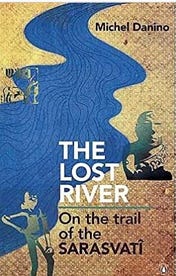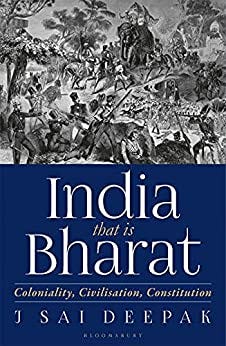
Conflict and discontinuity in Indian history is an obsession with Marxist historians writing Indian history. Any fresh development in India is seen as a revolt against the past; the new is considered as an improvement over the old. Few narratives that pop out from this camp are (1) Gangetic civilization which arose after the decline of the Harappan civilization had no connection to the latter (2) Buddhism was a revolt against Hinduism (3) The India born in 1947 was an artificial entity created by the British and had no connection to ancient Bharat.
All these are wrong. The details show that continuity, not discontinuity, was an Indic obsession. In this article, we will look at counter arguments to the above, look at the Marxist game plan, and see how our civilization counters that.
The Living Past
If you could time travel to the Saraswati-Sindhu-Narmada period, it will surprise you to see many familiar things. You will see tablets with swastikas incised on them. The “endless knot” pattern used in rangolis and the “intersecting circles” pattern seen at Bodh Gaya will be all around. Buddhists and Jains will find familiarity with the pasupati seal; a Hindu will say, that’s how Shiva is represented. Remember the story of “Crow and Fox”. You will find pottery which depicts that.
In the 1990s, while the Harappan city of Dholavira was being excavated by the ASI, an Italian team visited Kampilya in Uttar Pradesh. When the Italian team presented the dimensions of the ‘Drupad Kila’ to the team which was excavating Dholavira, it surprised them since it coincided with Dholavira’s dimensions. But the two cities were separated by 2000 years in history.
The similarities don’t end there. Many years ago Michel Danino, the author of The Lost River was showing slides of excavations done at Banawali to Vedic scholars in Kerala. They identified the shapes of the fire altars as those being in use even now. In fact, they found evidence in other places like Rakhigarhi, Kalibangan and other places in Gujarat. Michel Danino’s book, has a chapter which covers these continuities. What we see is a cultural continuum between the Indus and Ganges civilizations. There was no “Vedic night” or “Dark Ages”
With Buddhism, the narrative is of a revolt against Brahminism (whatever that is.) This revolt model here is how Martin Luther revolted against the Catholic church. Instead, what happened was constant debates between various darshanas and various Buddhist traditions for a thousand years. According to Ananda K. Coomaraswamy, it was not a revolt. In his book, Hinduism and Buddhism, he writes that the distinction can be found only by people who study Buddhism superficially. According to him, there is nothing he could find which could be called as social reform or a protest against the caste system. Instead, AKC says Buddha can be called a reformer because he had discovered the ancient ways of the awakened. The Buddha also praised the Brahmins, who remembered the old path of the contemplatives that led to Brahma.
Finally, with 1947, just read the debates in the Constituent Assembly on what the name of the new nation should be. J Sai Deepak’s book, India, that is Bharat elaborates on this. The framers of the Indian constitution acknowledged the umbilical cord that connected independent Bharat with its civilizational history. The civilizationally conscious suggestion put forth by several members of the Constituent Assembly resulted in “India that is Bharat” in Article 1. With this statement, they acknowledged they were putting a statist apparatus for an ancient civilization of which they were the descendants. J Sai Deepak writes, “ In other words, there is no basis for the colonialized myth that Bharat was created by the British colonizer prior to which it lacked a sense of self and history.”
In fact, preserving continuity is in the Indic DNA. Sandeep Balakrishna’s new book, Stories from Inscriptions, gives many examples of how administration was done by various kings and the principles they upheld. One secret to the longevity of the Vijayanagara empire was because of their tendency to preserve traditions of the past. This is embodied in the Kannada word Pūrvadamaryāde which means that ancient traditions and customs have to be continued. This is just not for religious traditions. Old tax rules were maintained. The king honored local traditions. Festivals remained unchanged. Temples got support. Ancient usage was equivalent to law. The more ancient a tradition was, the more sanctity was added to it. According to Dharmasastra, the ruler had to preserve and defend ancient customs, even of conquered lands.
Every ruler – from chieftains to kings — proclaim that they are the maintainer of traditions. In judicial cases, they claimed they were carrying on laws that existed from ancient times. No drastic changes happened. No revolutions happened. It was understood that the lowest unit of administration, like village, should have the maximum autonomy. They kept interference to a minimum.
Puppet Masters
Why do “Eminent Historians” have such fascination with proving a non-existent discontinuity? What is the basis of their ideology.? From a surface level, it seems as if they want to ferment violence by dividing people.
Rajiv Malhotra and Vijaya Viswanathan’s new book, Snakes in the Ganga, explores this in the context of Critical Race Theory. According to them, to understand the root of all this divisiveness, one has to go back to the philosophy of history of Hegel. According to Hegel, the world spirit moves through evolutionary stages. Western nations are at the forefront of this evolutionary stage and the goal of all other nations is to aim for that glorious future. There is a linear trajectory that all civilizations should go through. Subjugating Native Americans and colonizing India is justified by this principle. All of that is done for the benefit of Native Americans and Indians to get them ahead on this linear civilizational highway.
What about the culture and traditions of Native Americans and Indians? For progress to happen, the prevailing paradigms have to be demolished. The existing thesis must be countered with an anti-thesis. The destruction caused by the clash of these two will produce a synthesis and the new truth that emerges is higher than the old thesis and anti-thesis. Conflict, destruction and violence are desirable for progress. In this model, there is no way each side can accommodate each other peacefully.
Recently, an “old, rich, opinionated and dangerous” puppet master of regime change came out in the open against Indian democracy. Apparently, the will of the Indian voters was not to the liking of this non-Indian. Hence, conflict has to be manufactured, and the country has to burn. To create violence, groups have to be pitted against each other and for that, hostile narratives have to be created and propagated. To perform this missionary work in India, he has a network of NGOs, media and “eminent historians.” It’s not just him, but Harvard is now the epicenter of this work and Indian billionaires fund them. In this war, history is a weaponized. At the end of this war, the puppet master becomes rich, useful idiots are discarded and civilization is a casualty.
Books Referenced in this article
1. The Lost River by Michel Danino
2. Hinduism and Buddhism by Ananda K. Coomaraswamy
3. India, that is Bharat by J. Sai Deepak
4. Stories from Inscriptions by Sandeep Balakrishna
5. Snakes in the Ganga by Rajiv Malhotra and Viswanathan


















